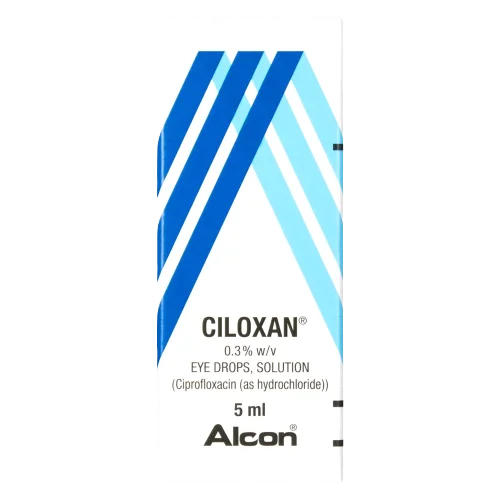The number of drops depends on how your doctor wants you to use it daily. You may notice its effects on symptoms within 2-3 days. Your doctor may suggest frequent usage in the first two days to expedite the improvement for quick relief from conjunctivitis, also known as pink eyes or infected ulcer of the cornea.
Patients find it safe when used as prescribed. You might experience a mild burning sensation for a brief period or eye discomfort. Some doctors may prescribe one drop two to four times daily in the affected eye (s) for 4-5 days or more. Monitor the side effects. They are usually temporary and mild. Inform your doctor if you experience severe side effects.
What is Ciloxan?
Ciloxan eye drops are a powerful and effective option for bacterial eye infections like bacterial conjunctivitis and infected ulcers in the cornea. Ciloxan eye drops work by targeting and eliminating the bacteria responsible for eye infections. The active ingredient, ciprofloxacin hydrochloride, is a fluoroquinolone antibiotic. It acts by interfering with the ability of the bacteria to grow and replicate. The medication delivers an effective and focused treatment for bacterial eye infections by disrupting bacterial DNA processes, ensuring relief and protection from further complications.
Ciloxan Mechanism of Action
Inhibits Bacterial DNA Gyrase and Topoisomerase IV
Ciprofloxacin blocks two critical bacterial enzymes, DNA gyrase, and topoisomerase IV, essential for bacterial DNA replication, transcription, and repair. Without these enzymes, bacteria cannot replicate or repair themselves, leading to their death.
Bactericidal Effect
Unlike some antibiotics that merely stop bacterial growth, ciprofloxacin actively kills the bacteria, leading to faster resolution of the infection.
Localized Action
When applied as eye drops, the medication targets the site of infection (the conjunctiva or cornea). It provides high concentrations of the antibiotic where you need the most while minimizing systemic absorption.
How does it reduce the symptoms?
Reduces Bacterial Load
Eliminates bacteria, causing redness, swelling, and discharge in infections like bacterial conjunctivitis or corneal ulcers.
Prevents Spread
Stops the infection from spreading to other parts of the eye or adjacent tissues.
Promotes Healing
By clearing the infection, it allows the natural healing processes of the eyes to restore normal function.
Key Benefits of How It Works
Broad-Spectrum Activity
Effective against gram-positive and gram-negative bacteria, including Pseudomonas aeruginosa, a common cause of severe eye infections.
Rapid Action
Ciloxan medication relieves infection-related discomforts quickly, like redness, irritation, and excessive tearing.
Direct Application
The Ciloxan eye drop targets the infection site with minimal impact on the rest of the body.
What are the Uses and Benefits of Ciloxan?
Ciloxan eye drops containing the active ingredient ciprofloxacin hydrochloride are a prescription antibiotic medication used to treat bacterial infections of the eye. Ciprofloxacin is a fluoroquinolone antibiotic that works by killing the bacteria causing the infection or inhibiting their growth.
Uses of Ciloxan Eye Drops
Bacterial Eye Infections
- Effective for treating a range of bacterial infections in the eye, such as bacterial conjunctivitis (pink eye).
- Commonly prescribed for infections caused by susceptible bacteria like Staphylococcus, Streptococcus, and Pseudomonas aeruginosa.
Corneal Ulcers
- Doctors often use Ciloxan eye drops for corneal ulcers (open sores on the cornea) caused by bacterial infections.
- It helps prevent the infection from worsening and supports healing.
Post-surgical Prophylaxis
Doctors may use it after eye surgery to prevent bacterial infections.
Benefits of Ciloxan Eye Drops
Broad-spectrum Antibiotic
Effective against a wide range of bacteria, including gram-positive and gram-negative strains.
Rapid Action
Begins working quickly to eliminate bacteria and reduce symptoms like redness, swelling, and discharge.
Localized Treatment
Targets the infection directly in the eye, minimizing systemic side effects compared to oral antibiotics.
Prevents Complications
Ciloxan Treats infections promptly to reduce the risk of complications, such as vision impairment.
Easy Application
The dropper bottle design allows for convenient and precise application.
Precautions
Avoid using it in viral or fungal infections.
Ciloxan is only effective against bacterial infections. One should not use it for viral (e.g., herpes simplex) or fungal eye conditions. These dosages are general recommendations and cannot substitute professional medical advice. Always use Ciloxan as your doctor prescribes to ensure safe and effective treatment.
Allergy to Ciprofloxacin
If you are allergic to ciprofloxacin or other fluoroquinolone antibiotics, do not use Ciloxan.
Contact Lenses
Avoid wearing contact lenses while using Ciloxan until the infection clears.
What are the Dosages of Ciloxan?
The dosage of Ciloxan eye drops depends on the condition and the severity of the infection.
Bacterial Conjunctivitis (Pink Eye)
Initial Treatment (First 2 Days)
Instill 1-2 drops into the affected eye(s) every 2 hours while awake.
Subsequent Days (Day 3 to 7)
Instill 1-2 drops every 4-6 hours while awake.
Corneal Ulcers
Day 1: Instill two drops into the affected eye(s) every 15 minutes for the first 6 hours. Thereafter, instill two drops every 30 minutes for the rest of the first day.
Day 2: Instill two drops every hour while awake.
Day 3 and Onward: Instill two drops every 4 hours while awake.
Continue treatment for at least 14 days or as directed by your doctor. Treatment may extend based on the severity of the ulcer.
Ciloxan Dosing Tips
Complete the Full Course
Even if symptoms improve, continue using Ciloxan for the entire prescribed duration to prevent a recurrence or antibiotic resistance.
Shake Well
Shake the bottle gently to ensure the solution you mix well.
Avoid Contamination
Do not touch the dropper tip to your eye or any surface to prevent infection.
Wait Between Drops
If you use multiple drops or other eye medications, wait 5-10 minutes between applications.
Missed Dose
If you forget a dose, apply it as soon as you remember. If it’s close to the next dose, skip the missed one and return to your regular schedule. Do not double-dose.
Overdose
An overdose is unlikely because of the localized nature of eye drops. However, if you suspect an overdose (e.g., applying too frequently or accidentally ingesting it), contact a healthcare professional.
How to take Ciloxan?
Steps for Taking Ciloxan Eye Drops
Prepare for Application
Wash your hands thoroughly with soap water to reduce the risk of contamination. If you wear contact lenses, remove them before applying the drops. Wait at least 15 minutes after using Ciloxan before reinserting your lenses unless your doctor advises otherwise.
Shake the Bottle
Shake the Ciloxan bottle gently to ensure the solution is well-mixed.
Position Yourself
Tilt your head back and look upward. Gently pull down your lower eyelid to create a small pocket or sac.
Apply the Drops
Hold the bottle close to your eye without touching the dropper tip to your eye or any surface. Squeeze the bottle gently to release 1-2 drops into the lower eyelid pocket. Do not blink excessively or rub your eyes after applying the drops.
Close Your Eye
Close your eye gently and press lightly on the inner corner of your eye (near the nose) for 1-2 minutes. It helps prevent the medication from draining out through your tear duct.
Wipe Away Excess
Use a clean tissue to blot away any excess liquid around your eye.
Repeat for the Other Eye (if infected and prescribed)
If both eyes are affected, repeat the process for the second eye using the same steps.
Avoid Contamination
Do not touch the dropper tip to your eye, eyelids, or surface.
Wait Between Applications
If you use multiple eye medications, wait 5-10 minutes between applications to ensure proper absorption.
Store Properly
Keep the bottle in a cool, dry place away from sunlight, and do not freeze it.
Missed Dose
If you miss a dose, apply it as soon as you remember. If it is close to your next dose, skip the missed one and continue your regular schedule. Do not double-dose to make up for the missed application.
When Should I Avoid Ciloxan or Use Ciloxan Cautiously?
Allergy to Ciprofloxacin or Fluoroquinolones
Do not use Ciloxan if you are allergic to ciprofloxacin hydrochloride, other fluoroquinolone antibiotics, or any ingredients in the formulation.
Symptoms of an allergic reaction may include rash, swelling, itching, or difficulty breathing.
Non-Bacterial Eye Infections
Ciloxan is only effective against bacterial infections. Avoid using it for:
Viral infections (e.g., herpes simplex or adenoviral conjunctivitis).
Fungal infections of the eye. These conditions require specific antiviral or antifungal treatments.
Severe Eye Conditions Requiring Different Treatment
If you have uveitis, iritis, or macular edema, Ciloxan is not the correct treatment unless prescribed by a doctor for a secondary bacterial infection.
Pregnancy and Breastfeeding
While ciprofloxacin is safe, consult your doctor before using Ciloxan if you are pregnant, planning to become pregnant, or breastfeeding. Limited studies exist on its safety in these cases.
Contact Lenses during Active Infection
Avoid wearing contact lenses while treating an active eye infection with Ciloxan, as this can worsen the infection and irritate the eyes. You can resume wearing lenses after the infection has cleared.
Pre-existing Allergic Reactions
If you develop severe redness, swelling, or irritation after using Ciloxan, discontinue use immediately and consult a doctor. These may be signs of hypersensitivity.
Overuse or Unnecessary Use
Do not use Ciloxan without a confirmed bacterial infection. Misuse of antibiotics can lead to antibiotic resistance, making future infections harder to treat.
Recent Eye Surgery or Trauma
Avoid self-medicating with Ciloxan if you have had recent eye surgery or injury unless prescribed by a doctor. Post-surgical infections often require a tailored treatment approach.
What are the Side effects of Ciloxan?
Common Ciloxan Side Effects
- Eye irritation, mild burning or stinging upon application, itching or discomfort in the eyes, redness in or around the eye (conjunctival hyperemia)
- Dryness or Foreign Body Sensation: A feeling of something in the eye
- Watery eyes after applying the drops
- Temporary blurring of vision immediately after use
- Crust Formation: formation of a white or yellow crust around the eye as the infection clears
Severe Ciloxan side effects
- Allergic Reactions (Hypersensitivity)
- Severe Eye Irritation or Pain
- Vision Changes
- Signs of Infection or Inflammation
- Corneal Damage or Ulcer Worsening
- Prolonged Eye Sensitivity
- Joint or tendon pain/swelling (tendonitis or tendon rupture)
- Nausea, vomiting, or diarrhea
- Severe headache or dizziness





